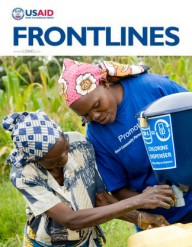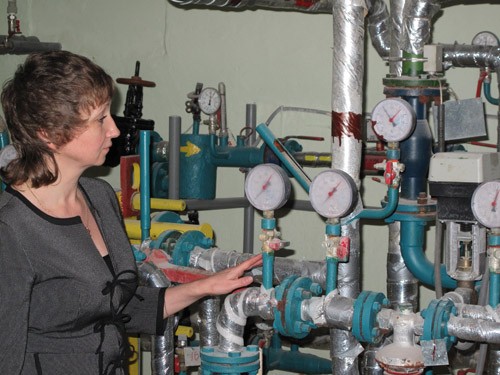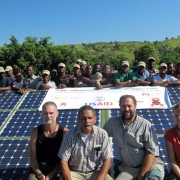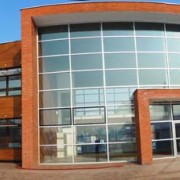 Four- and 5-year-old girls from “Kalynka” group attend a music class.
Roman Woronowycz
Four- and 5-year-old girls from “Kalynka” group attend a music class.
Roman Woronowycz
 Four- and 5-year-old girls from “Kalynka” group attend a music class.
Roman Woronowycz
Four- and 5-year-old girls from “Kalynka” group attend a music class.
Roman Woronowycz
KYIV – Ukraine, Europe’s largest and most inefficient energy consumer, also pays the highest rate in Europe for imported gas. Forty percent of all energy use in Ukraine is gas—two-thirds of which is imported. After many years of indifference, the country is now exploring alternatives to make its cities and towns more energy efficient.
Since 2009, USAID has partnered with 38 Ukrainian local governments to provide expertise and technology to better utilize the country’s energy resources, and developed formal energy plans for 25 of them. It has helped city officials from Kyiv to Yevpatoria evaluate and improve energy efficiency in public places, such as kindergartens and hospitals.
At Yevpatoria City Hospital, Dr. Dmytro Poberskii, the chief physician, watched helplessly as the 40-year-old communal health-care facility he managed increasingly fell victim to neglect caused by a lack of resources for renovation. He searched for ways to maintain basic services, but he couldn’t do much about a poorly designed and deteriorating building that in some places was leaking heat like water through a strainer. The windows, roof and cracks in the walls were particular villains.
“The doctors had to wear their coats even while performing medical procedures,” explained Dr. Poberskii. With the temperature inside the hospital often barely climbing above 52 degrees Fahrenheit on some days, the staff and patients had no choice but to endure the cold.
When Dr. Poberskii heard the city had chosen his hospital for an energy audit, he was guardedly optimistic that things might finally begin to improve. His hopes were fulfilled thanks to the USAID Municipal Heating Reform project, which in 2010 chose Yevpatoria as one of 25 cities to participate in an energy efficiency initiative designed to show local governments how to better conserve energy and improve the lives of their residents.
Beginning in 2010, USAID singled out 13 of the 25 cities for special demonstration projects; 34 projects have been completed. The 13 cities are expected to save a combined total of $20 million annually as a result of the 34 pilot projects, in no small part due to an additional $225 million in investments leveraged for increasing energy efficiency.
To qualify, cities had to meet strict criteria, including involvement by high-level city officials, a willingness to share the city’s balance sheets, and the ability to provide or obtain additional financing, develop specific municipal energy ordinances, and organize a separate municipal energy management committee.
Yevpatoria, which had already received USAID training on energy efficiency and an energy audit of its municipal heating system, was among the 13 pilot cities. The city hospital was chosen to receive thermal insulation for the building’s exterior, new windows, energy efficient lighting, a modular gas-fired boiler, and major repairs to the ventilation system.
The $260,000 investment by the city, matched by $153,000 in funding from USAID, would result in an annual savings of $76,000 to the hospital’s energy bill.
Valentyna Sergienko, an elderly Yevpatoria citizen who has used the hospital’s services for 30 years, praised the results: “Long waits were always difficult because of the cold hallways and freezing examination rooms. Now everything has changed.”
School Kids Warm Up to Learning
City officials in Ukraine’s capital, Kyiv, also took full advantage of the opportunity USAID provided. The city of nearly 2.8 million had watched its municipal energy bill rise five-fold over the last three years, going from $25 million to $125 million. Kyiv City administration head Oleksander Popov quickly accepted the offer to develop a demonstration project in one of Kyiv’s schools.
Today at Kyiv’s Kindergarten No. 573, children who once had to wear coats during the winter to stay warm in frigid classrooms are now comfortable without them. Denys Pavlovskyi, 6, and his classroom partner, Mitya Matushko, 6, were upfront in their assessment of the changes.
“It used to be so cold,” said Denys.
“And then it got warm,” chimed in Mitya.
The newfound warmth in the rooms of Kindergarten No. 573 is the result of a new heating system, including radiators and ventilation pipes, fresh insulation, new energy-efficient lighting and a weather-based climate control system. The school saves additional energy through solar panels installed by the project. An obsolete heat supply system, worn-out equipment, and a lack of modern energy efficient lighting limited the ability of the facility management to maintain a comfortable indoor temperature for a productive learning atmosphere. These inefficient systems cost the school an additional $50,000-$70,000 per year in operating costs.
“I used to wander these halls thinking how the school might look if we could find the money for improvements, never really thinking that one day we would receive all this,” explained Natalya Shut, the school’s director.
To help cash-strapped municipal budgets develop the financing required to participate in the project, a central component of the USAID effort involved generating private sector financial partners.
DTEK, the Donetsk-based industrial conglomerate and one of Ukraine’s largest corporate entities partnered with the city to bring the USAID pilot “Energy Efficient Schools Program” to 11 schools in Kyiv. USAID had already successfully introduced the program to 24 schools in eight other cities.
“Private sector involvement and buy-in have been essential, not only to accomplishing energy efficiency project objectives, but ensuring the sustainability and momentum of energy efficiency activities throughout Ukraine,” said E. Jed Barton, USAID’s Europe regional mission director.
Countering Skepticism
Many Ukrainians remain uninformed or skeptical regarding the benefits and cost savings provided by energy conservation, so the project also focused on education and public outreach. Public service announcements ran in six project cities, on 1,400 billboards, and on the extensive Kyiv subway system. It also involved celebrity concerts and a weekly national television show where celebrities discussed their own energy conservation efforts before an estimated 2 million viewers.
In addition, the project team put together a school manual and an educational training program for schoolchildren, which the Ministry of Education and Science has approved as part of a nationwide public education curriculum on energy conservation. DTEK has now asked USAID for the rights to use the USAID school manual as part of its own energy-awareness educational campaign.
Meanwhile, Kyiv administration head Popov has agreed to extend the pilot project completed at Kindergarten No. 573 to 600 other kindergartens and school buildings throughout the city. The city government expects that the results will help lower its energy bill for schools and kindergartens by 60 percent annually.














Comment
Make a general inquiry or suggest an improvement.